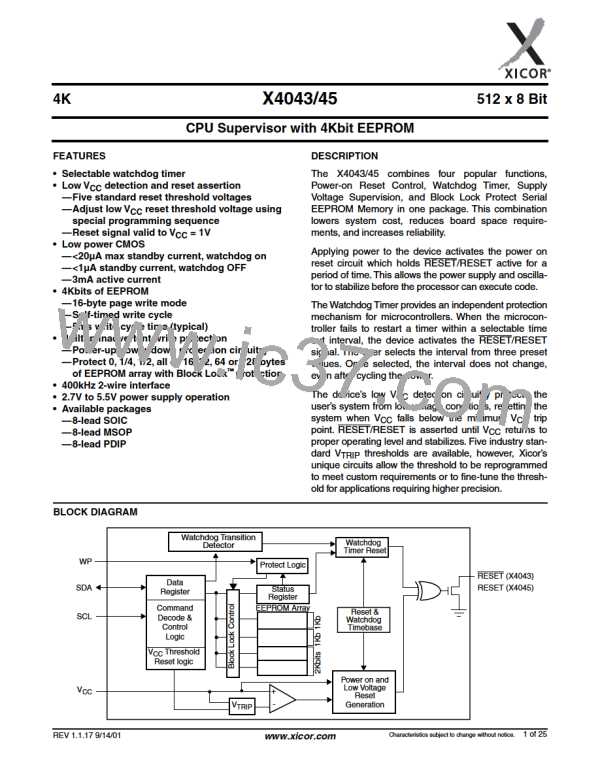X4043/45
Acknowledge Polling
Figure 13. Acknowledge Polling Sequence
The disabling of the inputs during nonvolatile cycles
can be used to take advantage of the typical 5kHz write
cycle time. Once the stop condition is issued to indicate
the end of the master’s byte load operation, the device
initiates the internal nonvolatile cycle. Acknowledge
polling can be initiated immediately. To do this, the mas-
ter issues a start condition followed by the slave
address byte for a write or read operation. If the device
is still busy with the nonvolatile cycle then no ACK will
be returned. If the device has completed the write oper-
ation, an ACK will be returned and the host can then
proceed with the read or write operation. Refer to the
flow chart in Figure 13.
Byte Load Completed
by Issuing STOP.
Enter ACK Polling
Issue START
Issue Slave Address
Byte (Read or Write)
Issue STOP
NO
ACK
Returned?
Serial Read Operations
YES
Read operations are initiated in the same manner as
write operations with the exception that the R/W bit of
the slave address byte is set to one. There are three
basic read operations: Current Address Reads, Ran-
dom Reads, and Sequential Reads.
NO
Nonvolatile Cycle
Complete. Continue
Command
Issue STOP
Current Address Read
YES
Internally the device contains an address counter that
maintains the address of the last word read incre-
mented by one. Therefore, if the last read was to
address n, the next read operation would access data
from address n+1. On power up, the address of the
address counter is undefined, requiring a read or write
operation for initialization.
Continue Normal
Read or Write
Command Sequence
PROCEED
Upon receipt of the slave address byte with the R/W bit
set to one, the device issues an acknowledge and then
transmits the eight bits of the data byte. The master ter-
minates the read operation when it does not respond
with an acknowledge during the ninth clock and then
issues a stop condition. Refer to Figure 13 for the
address, acknowledge, and data transfer sequence.
It should be noted that the ninth clock cycle of the read
operation is not a “don’t care.” To terminate a read oper-
ation, the master must either issue a stop condition dur-
ing the ninth cycle or hold SDA HIGH during the ninth
clock cycle and then issue a stop condition.
Figure 14. Current Address Read Sequence
S
t
S
t
o
p
Slave
Address
Signals from
the Master
a
r
t
SDA Bus
1
A
C
Signals from
the Slave
Data
K
Characteristics subject to change without notice. 11 of 25
REV 1.1.17 9/14/01
www.xicor.com

 XICOR [ XICOR INC. ]
XICOR [ XICOR INC. ]